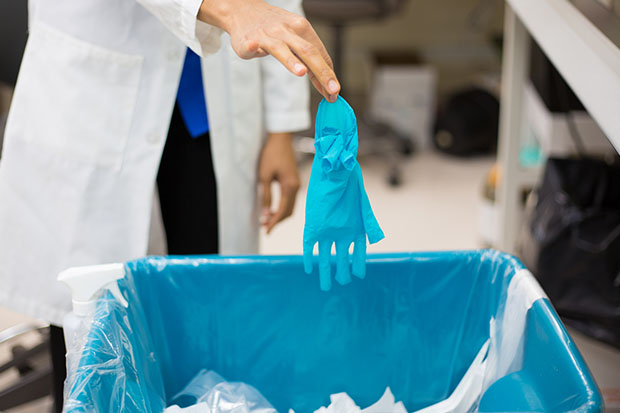Save Money with Proper Medical Waste Classification

One of the biggest issues businesses face when it comes to medical waste is the cost. And costs are only expected to increase due to an aging population and expansion of health services. So it makes sense that many companies are looking for ways to reduce waste without violating environmental laws.
Proper waste classification can help reduce the amount of medical waste generated in your facility. It sounds simple, but there are common issues businesses face when it comes to waste segregation.
Everyday Scenarios that Complicate Waste Classification
In the workplace, there are times that inconvenience can play a significant role in classification. In some facilities, there are red bags close by, but no trashcans, which can lead some employees to dispose of regular trash in a red bag. Others throw all of their waste into red bags for fear of not being compliant. Throwing ordinary trash bags into red bags is a common mistake. And once waste goes in, it cannot be taken out due to the risk of spills.
Poorly written guidelines regarding waste disposal is another common obstacle. For example, some facilities don’t have a clear definition of “body fluids,” which is an important criterion for identifying medical waste.
Medical Waste Defined
In a nutshell, medical waste is anything that contains significant amounts of blood and other potentially infectious materials (OPIM), such as:
- Semen and vaginal fluids
- Cerebrospinal fluid, synovial fluid, pericardial fluid and pleural fluid, peritoneal and amniotic fluid
- Saliva from dental work
- Body fluids with blood
- Unfixed human or animal tissue or organs
Materials that exhibit the following characteristics are termed medical waste:
- Items with liquid or semi-liquid blood and OPIM
- Items that will release liquid or semi-liquid blood or OPIM
- Items with dried or caked blood or OPIM
- Sharps contaminated with blood or OPIM
- Pathological or microbiological wastes
In many states, medical waste is further categorized into:
- Cultures and stocks
- Human blood and blood products
- Human pathological waste
- Sharps
- Animal wastes from research
Urine and feces are not medical waste. Diapers and urine cups should not be disposed of in red bags. The same goes for soiled (but not bloodied) gloves, table and tray covers, device packaging and empty medication vials.
What Not to Put Into Red Bags
The Occupational Safety and Health Administration (OSHA) states that items that are considered medical waste are those consisting of blood and OPIM, items that would release blood or OPIM if compressed or during handling, and contaminated sharps, along with pathological, microbiological and other potentially infectious materials.
This definition excludes several items often disposed of in red bags. Some facilities treat waste items with traces of blood or OPIM contamination as medical waste. Linens, soiled bandages, gloves, intravenous tubings and bottles that have blood or OPIM in extremely small amounts (not enough to cause contamination when compressed or released) are NOT considered medical waste items. They can be disposed of as municipal waste with no further treatment. Many of these items take up considerable space or weight in red bags, increasing your hauling and disposal costs.
To be considered medical waste, the waste item must be saturated or dripping with blood or OPIM, which can release contaminants when compressed or handled. Consider an item medical waste if it is made up of blood or OPIM, unfixed tissue or organ tissue, or microbiological or pathological waste.
NOTE: Even though a waste item may only have traces of blood or OPIM, employees must handle these wastes following universal precautions.
Save Money Through Proper Segregation and Disposal of Medical Waste
Segregating medical waste can result in significant savings. If your facility is generating a large amount of a particular type of medical waste, strict segregation reduces your total waste output. If you want to reduce costs, always segregate and dispose of medical waste according to the above-mentioned categories.
You can also dramatically reduce costs by switching your waste collection provider. Some providers have policies that greatly increase the cost of waste disposal. They tack on fuel surcharges, environment fees, transport fees and off-schedule collection fees that increase monthly bills, often without the customer’s authorization.
If your waste collection provider increases your bill every month for the same amount of waste collected and does not alert you to extra fees, switching to another lower-cost provider can reduce expenses.
Review Policies and Educate Staff
An audit of policy and employee behavior can also help reduce costs of waste disposal. Review the policies within your institution and make sure rules about proper segregation and disposal of medical waste are clearly stated. Give particular attention to policies defining medical waste and exposure control plans. If your medical waste definition is unclear, employees may dispose of other types of waste in biohazardous waste containers, which leads to unnecessary costs.
Meet with employees to address misconceptions regarding medical waste. Take the time to find out if other disposal needs are being met. Is there a lack of regular trash bins? Or is the placement of red bags awkward and inefficient? It is also a good idea to audit contents of trash containers and red bags. Take and use pictures of the contents to train employees. Regular auditing of red bags and tracking forms may be needed.